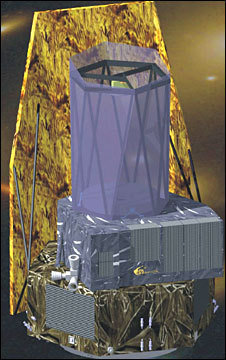EUCLID
Short Description:
EUCLID is a Cosmic Vision Survey Mission being proposed by ESA with the primary goal to map the geometry of the dark universe, to characterize dark energy and study dark matter. MPE is involved in the efforts of definition and design of a near infrared imaging photometer (NIP) to be flown on board the EUCLID satellite.
The EUCLID satellite payload consists in the current baseline of a 1.2 m Korsch telescope, a 3 mirror common opto-mechanical assembly and 3 scientific instruments dedicated to visible imaging (VIS), near infrared photometric imaging (NIP) and to near infrared spectroscopy (NIS). Passive cooling is foreseen to provide 170 K resp. 140 K for the focal plane detectors. Two observation modes are presently under study: step and stare versus continuous scanning (all-sky survey covering 20 000 deg2). The payload mass is about 660 kg including 300 kg for the three instruments with a possible launch into a L2 orbit at the end of 2020 and about 5 years lifetime.
NIP is the near infrared imaging photometric channel on board the payload. The assessment study on both imaging channels VIS and NIP (= NISP) – optimized for the weak lensing measurements – is led by CEA Saclay (France) and is done by a consortium of several institutes of 6 ESA member states and the US. CEA has nominated Alexandre Refregier as PI for NISP.
Project Type:
Instrument for Satellite
MPE Contribution:
The assessment study on NIP is led by MPE (Ralf Bender is Co-PI) in cooperation with MPIA Heidelberg. Further contributions to NIP are coming from ATC (UK), CEA (France) and from JPL (USA) for the FPA. The German part of the study will be partly funded by DLR.
The Max Planck Institute for Extraterrestrial Physics (MPE) is responsible for the overall optical design of the near-infrared instrument, in particular it procures all lenses and their mounts and performs the corresponding functionality tests. In addition to the hardware development, MPE is involved in the scientific data processing of the mission. LMU is co-leading the preparation of ground-based complementary data and their merging with the EUCLID visual and infrared data. Both institutes are represented in several science working groups, in the EUCLID Consortium Board and the ESA Science Team.
Status:
In early 2010 ESA's Science Programme Committee recommended that Euclid, along with two other M-class candidate missions (PLATO and Solar Orbiter) proceed to the next phase: a more detailed definition phase during which period the cost and implementation schedule for the mission must be established. This detailed definition phase was completed in mid 2011.
In October 2011 Euclid was selected by the SPC for implementation, with a launch planned for 2019/2020. This was finally confirmed in June 2012.
The nominal mission life time will be 6 years.
Links:
Optical and Interpretative Astronomy (web pages of the MPE department involved in the project)
News:
Looking into the dark: Ahead with the Euclid mission

